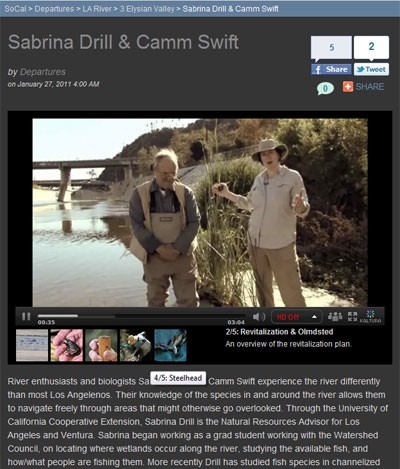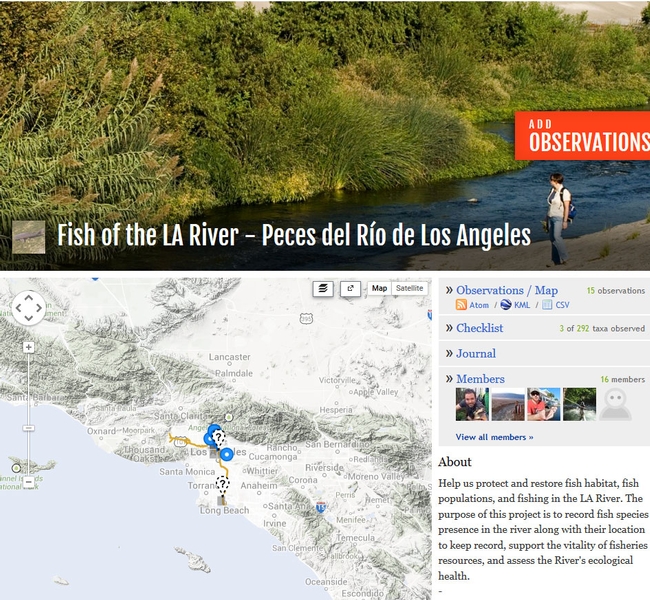
Posts Tagged: Los Angeles River
Heavy rains this winter may help native fish in the LA River make a comeback

Currently, the fish population in the river is almost entirely non-native. Released as bait by anglers, dumped by the city to eat unwelcome species, and aquarium fish set free by their owners now populate the river's waters.
The forecast heavy rains during the 2015-16 winter present an opportunity to determine whether nonnative fish will be washed out of the river and into the Pacific Ocean, giving native fish a new chance to become established.
"If we are ever going to fully understand the ecology of this river, and prospects for the return of species that evolved in it, we have to know first what's in it now, and how well those creatures do in extreme conditions," said biologist Rosi Dagit of the Resource Conservation District.
UC Cooperative Extension natural resources advisor Sabrina Drill was among a group of biologists and volunteers who surveyed the fish in the river in late November with seines, dip nets and rods and reels. After six hours, the team caught about 3,000 talapia, two dozen crayfish, a few hundred mosquito fish, one aquarium species and two Asian freshwater clams.
The research is funded by the Friends of the Los Angeles River.
Citizen science in the L.A. River expanding
The Friends of the Los Angeles River organization is expanding its citizen science monitoring of fish in the Los Angeles River to additional locations, reported Carren Jao in KCET Columns.
Since 2008, the volunteers have been catching fish in Elysian Valley of the L.A. River and delivering them for analysis to three biologists, including Sabrina Drill, UC Agriculture and Natural Resources Cooperative Extension advisor in Los Angeles County. The biologists found that the fish caught here were healthier and lower in mercury and PCBs than fish in the ocean. The surprising finding is likely due to the natural river bottom in the Glendale Narrows portion of the river.
Now volunteers will be turning their attention to parts of the L.A. River in Long Beach and the Sepulveda Basin to establish a baseline for those areas.
Citizen scientists can also help document the state of the L.A. River by contributing to a project created by UC ANR's Sabrina Drill on the web and smartphone app iNaturalist. Anglers can take a smartphone photo of their L.A. River catch and upload it to iNaturalist. The smartphone automatically records the time and day, and the GPS coordinates where the fish was caught. Much like iNaturalist does for birds, lizards, and insects, the L.A. River fish page creates a digital community where fishermen can boast of their accomplishments, but also build a record of the river's biodiversity using their smartphones.
UCCE expert featured in public TV video series
The public television affiliate in Los Angeles County, KCET, has posted a series of videos in its Departures series featuring UC Cooperative Extension natural resources advisor Sabrina Drill.
Departures is part of the KCET's Youth Voices digital literacy program, which engages high school students through workshops to become multimedia producers.
In this latest series of five videos, Drill and Camm Swift, a fishery biologist with the Natural History Museum, are filmed on the bank of the Los Angeles River chatting about the significant impact urban development, channeling, damns and introduction of non-native aquatic species has had on the ecosystem.
No native species still swim in the LA River and many riparian habitats - such as mudflats and wetlands - no longer exist.
"There's actually a big effort right now to do some large scale restoration of the LA River. The City of Los Angeles is heading that up," Drill said on the second video. "It's a long, long process, but they're in the feasibility study phase right now."
The student who produced the series, Mike Cadena, said in a commentary about the video series that joining the biologists on the riverbank was an amazing experience.
"What I was most amazed about was the river's potential for recreation. One of the biologists said that a long time ago there'd been plans to build all sorts of rec. centers and parks all along the river and this really got me thinking about what that would mean to all of Los Angeles," Cadena wrote.

KCET online series "Departures."
The flood-controlled LA River supports fish life
Long before European settlers arrived in America, the Los Angeles River was an important source of food and water for native peoples. Europeans settled the Los Angeles area in part because of the river and the fertile alluvial soils it provided. The river and its tributaries frequently flooded and changed course, forming wide alluvial floodplains that extended across southern Los Angeles from modern day Santa Monica to Long Beach. When Los Angeles began its transition to teeming metropolis and settled these flat floodplains, the river's natural characteristics led to disastrous flooding.
In the interest of saving lives and property, civil engineers sloped the banks and encased them in more than 30 miles of concrete, a move that completely altered the fishery. Recently completed UC Cooperative Extension research indicates that, despite the concrete and influx of pollutants from LA storm drains and sewage treatment plants, the Los Angeles River is still capable of sustaining life.
Working with Friends of the Los Angeles River, an organization interested in restoring the LA River to a more natural state, UCCE natural resources advisor Sabrina Drill surveyed the fish population in the river's eight-mile Glendale Narrows area, a section that, because of its underlying geology, was left with a natural bottom. The researchers discovered a diverse and bountiful fish population in this stretch of the river.
"To our surprise and delight, toxicity reports show the small number of fish we tested to be free of mercury and have extremely low levels of PCBs," Drill said. "This may not be true for the rest of the river. Glendale Narrows is one of the cleanest sections, probably because the natural river bottom cleans itself and because of the high quality effluent coming out of upstream water reclamation plants."
The survey identified eight species of fishes, none of them native, plus tadpoles and red swamp crayfish in the river. The eight fish species are: fathead minnow, carp, black bullhead, Amazon sailfin catfish, mosquito fish, green sunfish, largemouth bass and tilapia. They hail from Africa, South America, Eastern North America and Asia.
Whether reestablishment of native species to the river is possible remains to be seen, and may not be the most important factor in river restoration.
"Difficult though it may be, you can't make the LA River what it used to be simply by digging up the concrete," Drill said. "Because of all the development, the water we import, and changes in hydrology, temperature, and water quality, it’s not the same system it was before people settled here."
But restoration can still take place, and Drill believes that in the next 10 to 20 years, large-scale habitat restoration and restoration of some historical floodplains will dramatically enhance the ecological function and natural beauty of the Los Angeles River.
LA River Fishing
USC film maker Megan McCarty created a seven-minute documentary on fishing the Los Angeles River, which includes an interview with UCCE's Sabrina Drill. See the video here:
L.A. River Fishing from Meghan Mccarty on Vimeo.
Click the link below for the complete 21-page report on the Los Angeles River fish survey.
Los Angeles River Fish Study (pdf)

The Los Angeles River winds through urban metropolis.

